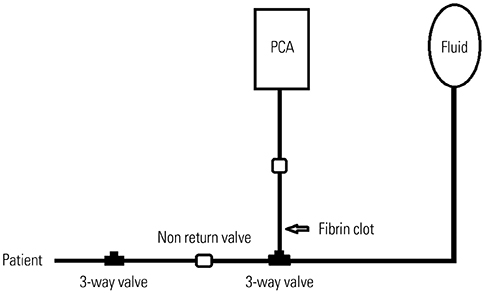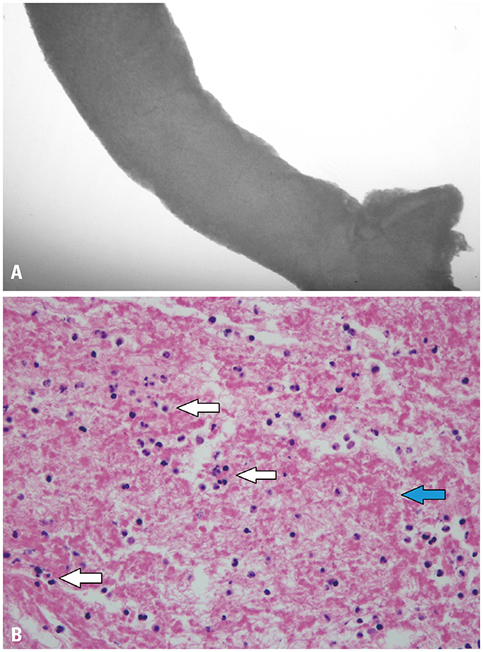Yonsei Med J.
2020 Mar;61(3):267-269. 10.3349/ymj.2020.61.3.267.
Fibrin Clot Mistook as a Worm in the Intravenous Line
- Affiliations
-
- 1Department of Anesthesiology and Pain Medicine, Inje University Ilsan Paik Hospital, Inje University College of Medicine, Goyang, Korea. jy925@paik.ac.kr
- KMID: 2470925
- DOI: http://doi.org/10.3349/ymj.2020.61.3.267
Abstract
- There have been several reports of foreign bodies being discovered in the intravenous set. In this case, the patient complained that he found a worm in his intravenous line. It was later confirmed as a long, white fibrin deposit by pathologic examination. This happened even though there was a non-return valve in the intravenous line. Also, since there were few red blood cells in the deposit, it did not look like a blood clot. In cases like this, we suggest that physicians keep this possibility in mind to reassure their patients.
Figure
Cited by 1 articles
-
Ensuring patient safety: the importance of prompt pathological examination for foreign bodies in intravenous lines
Min Hee Heo, Sang Il Lee, Kyung Woo Kim, Jun Hyun Kim
Anesth Pain Med. 2023;18(4):445-446. doi: 10.17085/apm.23069.
Reference
-
1. Madsen H, Winding O. Release of foreign bodies (particles) by clinical use of intravenous infusion sets. Biomaterials. 1996; 17:663–666.
Article2. Yorioka K, Oie S, Oomaki M, Imamura A, Kamiya A. Particulate and microbial contamination in in-use admixed intravenous infusions. Biol Pharm Bull. 2006; 29:2321–2323.
Article3. Pathak K, Yadav D. Percutaneous removal of intracardiac and intravascular foreign bodies. Med J Armed Forces India. 2011; 67:367–369.
Article4. Gschwind CR. The intravenous foreign body: a report of 2 cases. J Hand Surg Am. 2002; 27:350–354.
Article5. Song M, Wei M, Song Z, Li L, Fan J, Liu M. A foreign body in the cephalic vein: a case report. Medicine (Baltimore). 2018; 97:e11144.6. Ellger B, Kiski D, Diem E, van den Heuvel I, Freise H, Van Aken H, et al. Non-return valves do not prevent backflow and bacterial contamination of intravenous infusions. J Hosp Infect. 2011; 78:31–35.
Article7. Rutherford J, Patri M. Failure of antireflux valve in a Vygon PCA set. Anaesthesia. 2004; 59:511.
Article8. Crosby E. Intravenous infusions and one-way valves. Can J Anaesth. 1991; 38:799–800.
Article9. Ambesh P, Ambesh SP. A simple technique to prevent reverse flow of blood from intravenous line in ipsilateral arm with noninvasive blood pressure cuff. J Clin Diagn Res. 2015; 9:UL01.
Article
- Full Text Links
- Actions
-
Cited
- CITED
-
- Close
- Share
- Similar articles
-
- Fibrin Clot Delivery System for Meniscal Repair
- The effect of autogenous fibrin clot on meniscal repair
- Meniscus Repair with Fibrin Clot in Complete Radial Tear of Lateral Meniscus
- A Case of a Large Fibrin Clot Formed in a Plama Unit Collected by Donor Plasmapheresis
- Arthroscopic Meniscal Repair using Fibrin Clot for Horizontal Tear in Young Adults: A Case Report




